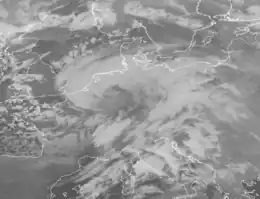Cyclone Egon
Cyclone Egon was a European windstorm that affected the north of France, Belgium and Germany during the night of Thursday 12 to Friday 13 January 2017. It caused three deaths, widespread power outages, and wind damage and significant snowfall, primarily France and Germany, but also in the Benelux states, Austria and Switzerland.[2]
 Storm Egon on January 13 | |
| Type | European windstorm, Extratropical cyclone, Winter storm |
|---|---|
| Formed | January 12, 2017 |
| Dissipated | January 13, 2017 |
| Highest winds |
|
| Lowest pressure | 982[1] mb (29.00 inHg) |
| Fatalities | 3 total |
| Damage | €275 million |
| Areas affected | France, Germany, Belgium, Netherlands, Luxembourg, Switzerland, Austria. |
The storm was the first to exceed the reporting threshold of €200 million with Perils.org since Cyclone Niklas in March 2015.[2] The total insured damages were estimated at €275m (final loss report).[3]
Meteorological history

On 12 January Egon developed unexpectedly from the trailing cold front of the low Dieter centred over Scandinavia.[4][5][1] Egon formed to the southwest of Ireland reaching western France by noon that day.[4] Egon formed “rather unexpectedly" as a secondary low on a cold front of Windstorm Dieter, before the depression began to deepen quite quickly as it headed for northern France.[1] The development of Egon coincided with a drop in the height of the tropopause especially between Brittany, Belgium and northeastern Germany. In more than 12 hours, the central pressure of the low pressure dropped to 980 hPa in France on 12 January.[6] Satellite water vapour imagery of the low was described as being suggestive of a Sting jet.[7]
Impact
The highest gust reported in France was in Dieppe which reported 146 km/h (91 mph), a value not seen there since the Great storm of 1987.[8] In Caen a gust of 131 km/h (81 mph) was reported, the strongest since the passage of Lothar in 1999.[9] Despite locally strong gusts, Egon was not considered by Météo-France to be one of the strongest historical storms to hit France as a whole, describing it as not comparable to the storm Lothar of 1999.[6]
Egon was accompanied by heavy rain and snow in places,[6] with the regions of Normandy and Picardy particularly affected,[8] where Egon caused power outages for over 330,000 households concentrated in these regions.[10]
Strong winds from Egon pushed in a significant portion of the west rose window of Soissons Cathedral to the northeast of Paris.[11] Debris from the window landed on the organ causing severe damage.
A unit of the Paluel Nuclear Power Plant, near Dieppe shut down automatically following the malfunction of a 400,000 volt transmission cable.[12][13] Severe gusts and heavy snowfall caused considerable damage and disruption in northern France and central Germany. Some of the greatest damage was incurred to forestry.[14]
In Germany, hurricane-force winds blew on the Saar and Rhineland-Palatinate, uprooting trees and causing power outages. Heavy snowfall covered much of the country and closed the roads, while the German Meteorological Service (DWD) indicated that some areas had received up to 30 cm (12 in) in a few hours, causing accidents. The airports of Frankfurt, Leipzig and Dresden cancelled their flights. A driver died in an accident, probably because of slippery roads, in Schleswig-Holstein. Another driver was also killed in an accident in Hesse.
On 13 January in Kaiserslautern the winds of Egon brought down the scaffolding surrounding a high-rise. Hurricane-force gusts from the low Egon swept through the Saarland on 13 January up to 126 km/h (78 mph).[15]
References
- "European windstorms under investigation, Egon a $100m+ loss". Artemis.bm - The Catastrophe Bond, Insurance Linked Securities & Investment, Reinsurance Capital, Alternative Risk Transfer and Weather Risk Management Blog. 20 January 2017. Retrieved 12 November 2017.
- "Europe's Windstorm Egon to Cost Insurers an Estimated US$223.3M: PERILS". Insurance Journal. 23 February 2017. Retrieved 24 February 2017.
- "Perils: Egon losses finalised at EUR275mn". www.trading-risk.com. Archived from the original on February 2, 2018. Retrieved 1 February 2018.
- "Thema des Tages - Archiv - EGON der Schnellläufer". www.dwd.de (in German). Deutscher Wetterdienst. 14 January 2017.
- Fischer, Jannick (15 February 2017). "Tiefdruckgebiet EGON". www.met.fu-berlin.de (in German). Retrieved 12 November 2017.
- "Bilan : tempête Egon des 12-13 janvier". www.meteofrance.fr (in French). Météo-France. Retrieved 2 March 2017.
- @KeraunosObs (12 January 2017). "L'image vapeur d'eau pourrait suggérer le développement d'un sting jet (courant-jet d'occlusion), d'où ces violentes rafales #tempête #Egon" (Tweet) (in French) – via Twitter.
- "Violent winter storm lashes northern France - France 24". France 24. 13 January 2017. Retrieved 12 November 2017.
- "Forte tempête (Egon) du nord de la France à l'Allemagne les 12 et 13 janvier". www.keraunos.org. Keraunos. 14 January 2017. Retrieved 2 March 2017.
- "Storm 'Egon' brings chaotic winter weather to Europe". Deutsche Welle. 13 January 2017. Retrieved 24 February 2017.
- "Tempête. La cathédrale de Soissons très endommagée par le vent". Ouest-France.fr (in French). 13 January 2017. Retrieved 12 November 2017.
- "Tempête : arrêt d'un réacteur à la centrale nucléaire de Paluel". www.paris-normandie.fr (in French). Retrieved 12 November 2017.
- "Intempéries : encore 35 000 foyers sans électricité". leparisien.fr (in French). 13 January 2017. Retrieved 12 November 2017.
- "Global Catastrophe Recap January 2017" (PDF). Aon Benfield. 8 February 2017. Archived from the original (PDF) on 19 February 2017. Retrieved 8 March 2017.
- "Wetter und Klima - Deutscher Wetterdienst - Archiv 2017 - Deutschlandwetter im Winter 2016 / 2017". www.dwd.de (in German). Retrieved 2 March 2017.
External links
 Media related to Storm Egon (2017) at Wikimedia Commons
Media related to Storm Egon (2017) at Wikimedia Commons- The Windstorm „EGON“ – an example for a rapid cyclogenesis Thomas Schumann DWD
